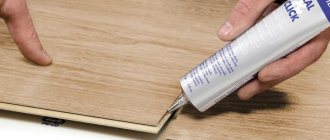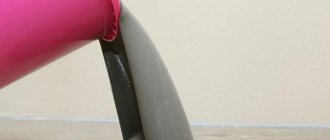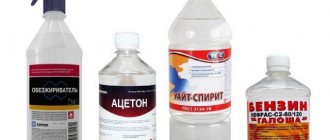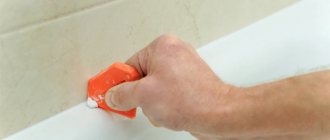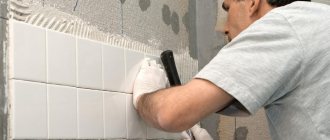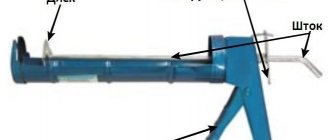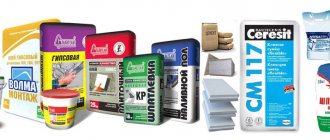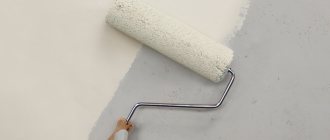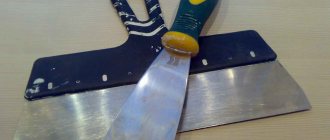Silicone sealant is widely used in various fields of activity. The material fills voids, seals seams, is well applied to various surfaces, and at the same time prevents the penetration of moisture, which prevents the development of fungal formations and mold. Before work, you need to know the consumption of sealant. To determine the indicator, influencing factors, methods, and manufacturers are taken into account.
How to calculate the required quantity
The table presented above shows the consumption rate relative to the dimensions of the tile and the depth of the joint.
But there are situations when the finishing material does not have standard sizes. In this case, you will have to carry out calculation operations to determine the grout consumption. To do this, you will have to use the following formula: (L+W/L×W)×T×Wsh×1.6=kg/m2,
where D is the length of the finishing material, W is the width of the finishing material, T is the thickness of the tile, Shsh is the width of the seam, 1.6 is a constant coefficient.
Let's look at the example of calculating mixture consumption. For example, the tile has dimensions of 40x40 mm. Its thickness is 4 mm, and the seam is 2 mm. First you need to add the length and width: 40+40=80 mm. Then multiply these indicators: 40x40 = 1600 mm2. You calculate the required coefficient, and for this you have to divide the first value by the second: 80/1600 = 0.05.
The video shows the consumption of grout for tile joints per 1m2:
Multiply the resulting value by the thickness of the finishing material, and then by the width of the seam: 0.05×4×2=0.4. Under the horses of the calculation, you have to multiply the constant coefficient by the calculated one: 0.4 × 1.6 = 0.64 kg of mixture will be needed to process 1 m2 of tiles. By following this simple flow rate, you can easily determine the amount of grout required to seal each m2 of wall surface.
This is due to the fact that excess glue not only increases the cost of repair work, but also disrupts the aesthetics of the mosaic, the primary color, which can change when in contact with the glue. To determine the consumption of the mosaic grout mixture, you must use the following formula:
(A+B)/(AxB) xCxDx1.6
The calculation examples presented above allow novice builders and all other people to obtain the required amount of material, thereby using it rationally and avoiding unjustified expenses.
This article will help you understand what the instructions for using litokol litochrom starlike epoxy grout are.
Calculation of the required amount of sealant using the formula
There is a fairly simple formula by which anyone can independently calculate the amount of sealing material. Or rather, this is not one formula, but two: first, you will need to determine the required volume of sealant, and then, by substituting the resulting value into formula No. 2, you will find out the mass of the material. So here they are:
V (sealant volume) = seam length x seam thickness x seam height
M (sealant mass) = V x r,
The consumption of the sealing composition directly depends on the width and depth of the seam
where V is the previously found volume of material; r is the density of acrylic sealant, which is on average 1500 kg/m3
Many of you may have a question about how to determine the length, thickness and height of a seam. We answer.
- The length of the seam to calculate the material consumption will be equal to one meter (1 linear meter): that is, you will only need to determine the amount of sealant for one meter, and then multiply the found value by the number of meters (they can be easily determined using a regular tape measure).
- The thickness of the joints is determined at the design stage of a wooden building; for most typical wooden structures (residential buildings, bathhouses, gazebos, log houses, etc.) the design thickness is usually 5-7 mm.
- The height of the seam in wooden structures is usually slightly less than 1/10 of the thickness of the logs between which these seams are located. That is, to determine the height of the seam, you will need to divide the thickness of the log by 10 and reduce the resulting value a little more.
So, let's try to use these formulas and determine the consumption of sealant using a specific example.
Let's say we need to seal the seams in a wooden log house, the thickness of the logs in which is 27 cm. We determine the height of the seam: 27/10 = 2.7 cm. We round down a little and get a seam height equal to 2.5 cm. The length of the seam is as in all calculations, ours will be equal to one meter. The design thickness of the seam, as mentioned above, is 5-7 mm; in our calculations we will use a value of 5 mm. We substitute the values into the formula for calculating the volume of sealant (in order not to make mistakes and not get confused in the calculations, we convert all values into meters) and get the following result:
How to determine the consumption of silicone sealant per 1 m of seam?
You can calculate the consumption of silicone sealant per 1 m of seam using the width and depth of the hole to be filled.
To do this, the width indicator is multiplied by the depth, the resulting result will show how much material is needed to fill a 1 meter long seam. If the seam is triangular, then the resulting result is divided into two. When using a special gun, material consumption is reduced, since the tool allows you to completely squeeze the product out of the container.
The usual type of seam has a width and depth of 6 millimeters; if these figures are larger, then when filling they use a special silicone cord, which serves as a seal.
If you plan to fill joints in wooden houses, then it is necessary to determine the width, height and length of the hole.
- Material calculations are made for the length of one linear meter. And then the resulting indicator is multiplied by the required length, which is measured with a tape measure.
- The thickness of the seams is calculated when developing a construction project; the standard indicator is up to 7 millimeters.
- In order to calculate the height of the joint to be filled, it is necessary to divide the thickness of the log by 10. And the resulting result is slightly reduced.
If you have doubts when calculating the material, you can go to the manufacturer’s special website and perform the calculation there, but for this you need to know all the indicators.
How to calculate sealant consumption depending on brand
Each manufacturer lists its material consumption according to certain parameters. TM Macroflex provides a calculation of the number of linear meters of a seam filled with sealant from one tube:
| Depth, mm | Width, 12 mm |
| 4 | 6,2 |
| 5 | 5 |
| 6 | 4,1 |
TM Ceresit indicates that the maximum permissible joint width is 15 mm. Costs are presented in the following amounts:
- 20x10 mm – 187 ml/m.p.;
- 10x10 mm – 93 ml/m.p.;
- 6x6 mm – 19 ml/m.p.
The best brands on the market
There are quite a large number of high quality polyurethane foam brands on the market:
- Materials of the Macroflex trademark;
- Polyurethane foam Titan;
- Belgian foam Soudal.
Most professional craftsmen call Soudal polyurethane foam number one among high-quality brands of mounting compound. First of all, because of its proven reputation over 50 years of presence on the market. The price for a 0.75 liter package is about 400 rubles.
Tytan polyurethane foam is considered the “workhorse” of most professional finishers, with a low price and a stable level of quality. The product of the German-Polish company Titan has some of the best characteristics:
- From one cylinder you can get up to 65 liters of material;
- Polymerization of the layer is completed in 30 minutes, after which the material can be processed or re-coated;
- The hardened mass of polyurethane foam absorbs only one and a half percent of moisture, the sound insulation level reaches 61 dB, and the fire resistance of the foam material is certified according to class B3.
The cost of packaging polyurethane foam is 250-300 rubles.
The technical characteristics of the Makroflex polyurethane foam 750 ml practically do not differ from the parameters of Titan. The Macroflex material produces up to 65 liters of foam per package with a density of 17-24 kg/m3 and record low thermal conductivity - only 0.03 W/m*K.
At a temperature of about 400°C, polyurethane foam begins to show signs of ignition, although the material itself is certified as self-extinguishing - B3. The only drawback is related to porosity; unlike Titan, Macroflex is capable of absorbing up to 20% moisture, so the material requires mandatory protection with decorative finishing.
Acrylic facade sealants
Sealant Sazilast 11 is used to seal joints with deformation up to 15%. Its advantage is its low price and extremely ease of use. The sealant does not contain solvents and is one-component. The ability to give the sealant any color led to its use for decorative purposes. In particular, such compositions are now widely used for sealing around the perimeter in the structures of wooden, metal and plastic window blocks as an internal vapor barrier layer. Being packaged in small containers, Sazilast 11 is widely used for indoor repairs.
Average consumption
The consumption of the composition for sealing, connecting, and sealing seams depends largely on the base material with which you will need to work. Depending on the type of material, you can find out the standard value that is set during construction and installation work. On average it is 6 mm. In some cases it is necessary to determine this value individually. If the joints have significant parameters - depth and width, then a special silicone cord is used for the work, which acts as a seal. Its use is especially important when working with wooden bases.
The average calculation of the consumption of a substance allows you to determine the appropriate container in which it is sold. To avoid unnecessary consumption, for example, if the depth and width of the opening are 5 mm, and its length varies within 10 meters, then 0.25 kg of sealant will be needed. Therefore, you can safely buy a 0.3 kg tube, leaving a little substance in reserve.
It is important when performing work, after carrying out average calculations of the consumption of the sealing composition, to observe these indicators when applying the substance. Therefore, you need to first prepare the surface, clean it of debris, dust, and other substances, and degrease it.
Both sides of the surfaces adjacent to the seam should be covered with masking tape to prevent sealant from getting on them. After this, it is important to correctly make a cut on the spout of the tube with sealant, after first placing it in the mounting gun. If all the preparatory work and consumption calculations are carried out correctly, then the substance fits ideally evenly into the gap and is leveled using a spatula.
It doesn’t matter whether repair and sealing work is being carried out outside or inside, or whether silicone sealant is selected for exterior work or to solve everyday problems. It is very important to spend a little time on preliminary calculations of substance consumption and familiarize yourself with the correct technology
This way, every master will be able not only to avoid overuse of substances, but also to save budgetary funds, as well as carry out the work of filling joints as quickly and efficiently as possible.
Consumption calculation
Very often, due to incorrectly determined joint dimensions, as well as a lack of experience in applying a polyurethane composition, there is an overconsumption of the substance. At the same time, increased consumption of sealant will not be the only drawback due to ignorance of the technology. If the seam itself is not filled with sealant correctly, its service life is significantly reduced.
First of all, it is necessary to evaluate the width and depth of the seam in order to determine the consumption of sealant. In bathrooms and washrooms, a suitable indicator for sealing gaps between the wall and a metal or acrylic bathtub, as well as a tiled covering on the wall, would be a seam 6 mm wide and 3 mm deep. If these parameters are met, then the consumption of silicone sealant for 1 m of seam will be 20 ml.
Most often, the sealant is sold in standard 310 ml packages. To understand the optimal consumption of a standard pack of silicone sealant for filling oblique seams and corner joints of walls, you can use the data in the table:
| Width in mm | 6 | 10 | 15 | 20 |
| Depth in mm | 4 | 7 | 10 | 14 |
| Seam length in m | 11.6 | 4.2 | 1.9 | 1 |
When filling standard semicircular seams with polyurethane sealant, the consumption will be significantly less, since it is distinguished by the classic proportions of the width and depth ratio, like 2 to 1. Also, the main indicators for standard sealant packaging are presented in the table:
| Width in mm | 6 | 10 | 15 | 20 |
| Depth in mm | 3 | 5 | 10 | 10 |
| Seam length in m | 16.2 | 5.8 | 2.6 | 1.5 |
In order for the seam to be filled correctly, accurately and evenly, it is necessary to cut off the spout of the sealant tube according to the instructions and use a spatula with a 6 mm edge. Trimming is very simple: you need to place the edge of the spatula tool at an angle of 45° relative to the spout. Using a construction knife, cut the plastic above the area where the size of the rib matches the diameter of the spout.
To make an accurate calculation of sealant consumption, you can use a special online substance cost calculator. Basic data (seam width and depth) is entered into the system and the result is provided automatically. To determine the consumption of silicone sealant, you can use a set of simple and convenient formulas, one of which allows you to determine the required volume of sealant and the mass of the substance required to treat all seams and surfaces:
- The volume of sealant V is equal to the product of the seam length, height and thickness.
- The mass of the sealant is determined as the product of the resulting volume of sealant V and R, where R is the density of the sealant, the average value is 1500 kg/m³.
It is enough to carry out calculations using the formula for one linear meter of seam. After determining the value, it is simply multiplied by the entire length required for sealing. To calculate this value, just use a simple tape measure.
On video: Working with sealant, consumption and application.
Silicone sealant: Consumption per 1 m of seam
Often, if the seam dimensions are incorrectly selected and there is a lack of experience in using silicone sealant, its overuse occurs. But increased material consumption is not the only disadvantage of non-compliance with the rules. A seam created without taking into account technology will not last long and soon enough it will have to be completely replaced.
To achieve the minimum cost of sealant per 1 m of seam, let's look at the optimal dimensions of the seam and the correct technology for its application. Let's start with the dimensions of the seam.
Sealant consumption per 1 m of seam
The main parameters of the seam that are responsible for its consumption are width and depth. Optimal values for use in corner joints between an acrylic or metal bathtub and a tile wall would be a joint 6 mm wide and 3 mm deep. With these parameters, you will need an average of 20 ml of silicone sealant per 1 meter of seam.
Let's look at an example of calculating the consumption of one standard package of silicone sealant with a volume of 310 ml per seam, depending on its shape (more about the shapes below). For the most optimal oblique seam when applied to the corner joint of a wall and a bathroom, the numbers are presented in the table:
The classic semicircular seam will be less expensive, since it has standard proportions of the width and depth of the seam - 2 to 1
Consumption table for semicircular seam:
To achieve this, you should use a special spatula with a 6 mm edge and correctly trim the spout of the silicone sealant tube. The spout is cut as follows: place a six-millimeter edge of a spatula against the spout at an angle of 45° and cut the plastic with a construction knife just above the place where the diameter of the spout coincides with the dimensions of the rib.
Smooth seam application technology
Applying the sealant should be done by holding the tube spout at an angle to the surface and evenly squeezing out the compound in a smooth motion along the entire seam. Squeeze out the amount of sealant with a small margin. The next step is to spray the surface of the seam and around it with a regular soap solution (just mix warm water with soap) of such a consistency that your finger slides over the surface of the tile. We treat the rubber spatula in the same way so that the solution does not stick or drag on it.
For a regular horizontal fillet weld, the application principle is simple: place the spatula at an angle of 90° so that the edge on its surface faces in the direction opposite to the movement. We smoothly move it along the applied sealant without pressure - just pull the spatula along the seam, it will move easily, since the surface will be slippery after treatment with soapy water. As a result, you will end up with excess sealant collecting on the spatula, and after going through the entire length of the seam, you can simply remove the accumulated mixture. Complete hardening of the seam occurs within two days, after which the treated surface can be safely used.
90° bent seam
Special technique is needed when processing horizontal seams that abut a vertical corner of the wall. The spatula is applied to the seam at an angle of 70°-80° so that the special cut (or edge) on the surface of the spatula is not visible to you. In this case, the side of the spatula hidden from you should not touch the surface of the seam.
We carry out the movement towards the vertical corner smoothly in the direction where the side of the spatula without a cut is facing. When the vertical angle is reached, we simply continue moving along the perpendicular wall, smoothly leveling the angle of the spatula to the seam to 90°.
Types of seams according to shape
In addition to width and depth, seams also vary in shape. Depending on the shape of the spatula for leveling the sealant, the seam can be made oblique or semicircular. In a semicircular seam, the outer plane of the seam is like a hollow with a depression along the entire length of the seam, while in an oblique seam this plane is flat.
The main advantage of the semicircular seam is the ease of application. You can even smooth out such a seam with your finger dipped in white spirit or soap solution. The main disadvantage of the semicircular shape is the edges of the seam (the narrowest point where the seam meets the surface of the tile), which are easily deformed. If you plan to regularly wipe the areas treated with sealant with a cloth, then it is better to choose an oblique seam.
Another significant disadvantage of a semicircular seam is its ability to retain water on its surface. After water gets on such a seam, it does not flow freely, but remains in the recess and later, when it dries, salts, metals and other impurities that are found in tap water are deposited in this place. They are, of course, easy to remove by wiping with a cloth, but as we said above, such seams do not withstand regular wiping very well anyway.
Tips from professionals for working with sealant
There are recommendations that are worth considering:
- Before starting work, examine the seam and determine the type. Cracks, depending on their shape, can be oblique or semicircular. The last option looks like a hollow with a depression. The oblique type has a smooth surface.
- Be sure to remove the previous material from the crack.
- For degreasing, use ethanol, acetone or dishwashing detergent.
- When the seam is completely filled, the sealant is leveled with a wooden spatula.
- The masking tape is removed only after the composition is completely dry.
- If the crack is deep, then a sealant is additionally used to save the amount of material.
- When sealing seams yourself, unforeseen incidents occur. The product may drip onto the floor. To remove material from the surface, use white spirit. Dip a cotton pad in the product and wipe off the excess. You can buy a composition for washing off silicone along with the material. If you don’t have either one or the other at hand, then take a rag, soak it in a soapy solution, and remove the sealant. If it has already dried, you can remove it with a knife. But you need to act carefully so as not to scratch the surface.
If you do not calculate the consumption of silicone sealant in advance, then there is a risk of buying more material than you actually need. Before purchasing the composition, make all the necessary calculations. After receiving the results, they purchase sealant and get to work. It is better to entrust the sealing of seams to the craftsmen - there will be additional savings.
Features of silicone sealing
Silicone sealant, in comparison with other sealing compounds, has become more widespread at a relatively low price. The silicone mixture can be used equally for interior and exterior renovation work.
In production, the paste-like mixture is filled into a plastic tube. The sealant is squeezed out of the container using a specialized tool - a gun. The cylindrical tube comes with a plastic tip, which is cut at an angle before starting work.
Composition of silicone sealant:
- Silicon dust. Necessary to impart viscosity to the working material.
- Antiseptics. Additives prevent the spread of mold and fungi on the surface of the mixture.
- Components that reduce the viscosity of the product. They increase the adhesive properties of the composition and contribute to better and more uniform filling of joints, thanks to better fluidity.
- Coloring pigments. For facade repair work, silicone compounds of different colors are used.
Features of this group of sealants:
- Elasticity. This parameter increases resistance to mechanical damage and abrasion. No cracks form on the surface of the material.
- Strength. Withstands significant loads. In case of possible shrinkage of structures, this parameter is taken into account.
- Frost resistance. Silicone is able to withstand climatic temperature changes over several cycles of freezing and thawing.
- Versatility. Suitable for working with surfaces made of various building materials - plastic, wood, metal and others.
- Moisture resistance. This advantage is applicable when carrying out repair work in wet areas.
- Resistance to UV radiation. The material is not afraid of direct sunlight.
- Resistance to temperature fluctuations. Impact range – from -50 to +200оС.
Types of silicone sealants
Silicone sealant, the consumption per linear meter of which should be calculated by the master, comes in two main types. These are neutral and acetate varieties. In the latter case, the sealant is used for smooth surfaces, such as glass. But this type of silicone is not suitable for metal. The glue contains acid. It has a negative effect on metal. Acetate silicone can only be used in well-ventilated areas.
Neutral sealant can be used on any porous surfaces. It has a high level of grip. Such silicones are resistant to temperature influences.
Another type of product presented is silicone sealant, which contains a fungicide. This prevents the development of fungus on the seams. This is necessary when using sealant in the bathroom or when performing outdoor work.
Comparison of polyurethane sealant with other compounds
Among the main types of sealants, the compositions are divided into:
- silicone based;
- polyurethane base;
- acrylic base;
- bitumen base.
We'll talk about their features further. The choice of one type of sealant or another depends on the individual characteristics of the material to be bonded; also important factors are the location of processing and the impact of external stimuli in the form of high or low temperature, high or constant humidity, vibration, mechanical stress, etc.
The main and quality-determining property for each of the sealants is its elasticity. In addition, a good sealant holds the seams securely under the influence of any irritants.
1. Acrylic-based sealant - they have the highest elasticity, but at the same time they do not hold their shape well and are prone to deformation. Suitable for indoor work. They are used in the process of installing windows and doors, in addition, they are used to seal cracks in the ceiling or walls. There are two options for these sealants:
- compositions resistant to moisture;
- non-moisture resistant sealants.
The first option is used in places with high humidity, and the second when gluing furniture. Acrylic sealant adheres well to paint, so it is almost invisible in the installation areas.
2. Silicone-based sealants are unstable to paint and varnish materials, therefore they have their own color palette. They are characterized by higher moisture resistance than acrylic ones and tolerate high and low temperatures very well. There are two types of silicone sealants:
- neutral;
- vinegar
The first option is used when working with metal products, since it is not capable of entering into various kinds of reactions with it. In addition, it will be used to seal the seams between tiles in places of high humidity, such as swimming pools and bathrooms. The second option is suitable for wooden, plastic and ceramic products. It is in no case suitable for processing products made of metal, as the surface will rust over time.
The only drawback of silicone-based sealants is the presence of an unpleasant odor that is released when working with them.
3. Polyurethane adhesive sealant has the highest strength and reliability. It has increased elasticity, is resistant to deformation, and is common when working outdoors, as it tolerates temperature changes, moisture, ultraviolet radiation, etc. well. In addition, this type of sealant tolerates painting and varnish well.
There is another type of sealants called façade sealants. These include materials that are best suited for working on the façade of a building. The best option for façade treatment is a polyurethane-based sealant. Since, when compared with silicone or acrylic sealants, it has higher strength before shrinkage, deformation and mechanical damage.
Silicone and thiokol-type compounds compete with polyurethane-based sealants. Since they, compared to polyurethane sealant, have slightly less elasticity and adhesion. Polyurethane sealant has more significant advantages than these compounds. It does not require preliminary surface preparation for its application, unlike silicone sealant. It is painted, and silicone sealant is available in a ready-made color, which can sometimes be difficult to match to the color of the surface.
Thiokol sealant has a shorter service life; unlike polyurethane, it requires periodic renewal of the seams. Therefore, despite the fact that the price of polyurethane sealant is slightly higher than that of silicone and other compounds, it surpasses them in many respects.
In order to buy polyurethane sealant, you should contact any construction supermarket or store.
Polyurethane facade sealants
Two-component polyurethane sealants are increasingly used in construction due to a number of advantages over other sealants. These sealants have high strength, good elastic recovery, gas tightness, and adhesion to concrete and other materials. The sealant can be applied to a damp surface. But there are also disadvantages - the need to use airtight containers.
The best representatives of polyurethane sealants are Sazilast 24 and Sazilast 25. Sazilast 24 sealant is ideal for sealing joints of building structures with deformation up to 25%.
Sealant Sazilast 25 has extremely high deformation properties, which allows it to be used for sealing joints of building structures with deformation up to 50%.
What affects consumption?
Each package of acryplast contains information about average consumption. But this standard has deviations, if you take into account some nuances. The consumption of silicone sealant is affected by the following parameters:
- Connection dimensions. If the seam is deep or thicker, then the consumption coefficient for each linear meter will increase.
- Preparing the work site.
- Method of application. When manually covering with a spatula, much more material will be used. It is better to use a special mounting gun.
- Master skill. Craftsmanship plays a big role when sealing a joint. The master does this quickly, while the material is laid evenly at the lowest cost.
- Variety of raw materials.
The last parameter indicates that the degree of demand depends on the type of raw material. So acidic, neutral, heat-resistant, sanitary acriplasts have different purposes and different levels of consumption standards.
Kinds
The range of facade sealants presented on the construction market is impressive. They are produced by domestic and foreign companies in entire lines of products. The classification of products is complex and takes into account the division of sealants into types according to several criteria:
- Degree of readiness – one-component and two-component mixtures. The former are immediately ready for application to joints and seams, while the latter must be pre-mixed, strictly adhering to the proportions.
- Based on their properties, they are classified into frost-resistant, rubber, waterproof, and heat-resistant compounds. When choosing a product, you need to consider the area of use of the sealant.
- In terms of color variety, there are transparent, colored, white sealants of the classic type and colored decorative mixtures in a wide palette of shades.
But the most important feature by which façade sealants for external use are classified is their component composition. Certain properties and characteristics of mixtures are given by fillers, modifiers and plasticizers, as well as special additives.
Silicone
Elastic, waterproof silicone-based pastes withstand temperature changes well. The structure resembles a plastic rubber material. There are silicone sealants for external seams of acidic, neutral and antiseptic types. Acetate mixtures have optimal strength, universal neutral products are suitable for any surface, and fungicidal pastes protect facades from the formation of fungus and mold. According to the technical specifications, silicone sealant for external seams retains its properties over a wide temperature range and successfully withstands most negative factors.
Acrylic
Among all sealing compounds, acrylic mixtures are the most environmentally friendly. The main area of application is interior work. But if modifying additives are introduced into the acrylic façade sealant or the mixture contains silicone or latex, the product can be used for external treatment of walls and structures. In this case, the water-repellent characteristics of the sealant and resistance to low temperatures are improved. Acrylic pastes are characterized by vapor permeability, light structure, and the possibility of finishing by painting or plastering. Compositions for external use have good adhesive properties.
Polyurethane
Polyurethane-based products are ideal for sealing interpanel seams - after hardening, the sealant acquires properties characteristic of high-quality rubber. Advantages of the compositions: elasticity, good resistance to mechanical stress. External seams treated with a polyurethane mixture effectively resist destructive processes upon contact with water, withstand sudden temperature changes, and do not shrink after vulcanization. The only drawback of polyurethane products is toxicity, but for outdoor work this disadvantage is not decisive.
A separate type of product is adhesive-sealants of different colors. Black glue is designed specifically for outdoor work (façade and roofing), as it has good resistance to ultraviolet rays. Transparent products are used for window structures, and white products are used to insulate plumbing joints.
Note: To seal the outside of the seams with sealant, you can use bitumen mixtures made on the basis of bitumen polymers. Such products have the properties of rubber and adhere well to facades made of various building materials.
Tile grout selection table.
| Name | SE 33 | SE 35 | SE 40 | SE 43 | CS 25 |
| Allowable joint width, mm | {amp}lt;5 | 4-15 | 10 | 5-20 | 5-30 |
| Color range, pcs. | 26 | 5 | 30 | 12 | 16 |
| Water resistance | |||||
| Hydrophobicity | together with ST 10 | together with ST 10 | |||
| Stain resistance | together with ST 10 | together with ST 10 | |||
| Resistant to sunlight and weathering | |||||
| Antifungal effect | |||||
| Fillet and expansion joints | |||||
| Connecting to a sink or bathtub | |||||
| Rooms with high humidity (kitchens, bathrooms, showers) | together with ST 10 | together with ST 10 | |||
| External cladding (facade, plinth, balcony) | together with ST 10 | together with ST 10 | |||
| Decorative stone or brick masonry | |||||
| Swimming pools | |||||
| High-load floors (garages, shops, porches) | |||||
| Glazed ceramic tiles | |||||
| Unglazed porcelain tiles or clinker | |||||
| Natural stone (except marble) | |||||
| Marble tiles | |||||
| Mosaic made of glass, stone or ceramics | |||||
| Rubble stone | |||||
| Decorative brick |
We invite you to familiarize yourself with what bathroom furniture is made of.
Specifications
Since sealants for external joints are exposed to a different set of factors than mixtures for internal use, they have completely different properties.
Auxiliary building materials of pasty consistency differ in composition and technical characteristics:
- High resistance to sunlight.
- Maintains integrity during temperature changes.
- Elastic structure that reaches at least 125%.
- High tensile, tensile and compressive strength.
- Resistance to the negative effects of chemicals.
- Low thermal conductivity and good vapor permeability.
- High adhesion to any surfaces of walls and facades.
- Fast curing, retention of shape during deformation.
- Maintainability, dense filling of cracks, painting.
The use of sealant for interpanel seams and joints is carried out in order to insulate the interior from the penetration of moisture and cold. Not only viscous compositions are suitable for this, but also special non-hardening materials. After application, they retain an elastic structure reminiscent of rubber - tapes, strands and cords. When heated, such sealants soften slightly and then return to their original structure.
Note: Professional-grade façade sealants are produced in bulk tubes for large-scale work using a gun. Household compounds are used for hermetically sealing joints on small surfaces.
Cost reduction
For small household jobs, the cost of consumables for arc welding is relatively small. Therefore, an increase for any reason in the amount of materials spent changes little.
It’s a different matter when it comes to welding work at a large construction site or repair shop. Here, overspending in a fraction of a percent turns into thousands of losses.
Measures aimed at reducing costs during welding work are carried out in the following areas:
- Staff development
- The quality of welding equipment, its timely maintenance, repair and adjustment if necessary.
- Improving the quality of materials used and preparation of joints.
- Using new technologies, replacing, where possible, manual welding with automatic and semi-automatic ones.
Streltsov V., a welder with 22 years of experience: An experienced welder, even with the worst equipment, will use less raw electrodes than a beginner. Of course, this does not exclude the need to adhere to technology.”
Properties
Polyurethane sealants are distinguished by the fact that they have excellent strength characteristics and have a long service life. They are not afraid of unfavorable environmental factors. They perform well even under water, so such mixtures can be used in a variety of areas.
Polyurethane sealants adhere seamlessly to most known materials, for example:
- with brickwork;
- natural stone;
- concrete;
- ceramics;
- glass;
- tree.
When open cavities are filled with a similar composition, it forms a very neat layer resembling rubber. He is absolutely not afraid of negative external factors
It is also worth paying attention to the fact that high-quality polyurethane sealant adheres 100% to certain substrates, regardless of their texture
After drying, the sealant can be painted. As a result, it will not lose its useful qualities and will not undergo deformation.
Polyurethane sealant is a fairly economical material, especially when compared with different analogues. One package may well be enough to treat a considerable area. For example, if you need to fill a joint that is 11 m long, 5 mm deep and 10 mm wide, then you will only need 0.5 liters of sealant (or 2 cartridges of 0.3 liters each).
As for the average material consumption with a seam width of 10 mm and a depth of 10 mm, it will be 1 tube (600 ml) per 6.2 linear meters.
Modern polyurethane sealants have a short drying time. However, we must not forget that this parameter is influenced by the density of the applied layer.
The polyurethane-based composition seamlessly adheres to other sealants. Thanks to this property, if the seal is damaged, the affected area can be easily repaired. As a result, the improvements will be almost invisible.
Polyurethane sealants are available in transparent and colored varieties. In stores you can find not only simple white, but also gray, black, red, yellow, blue, green and other colorful compositions.
Features and properties of sealants
Using a polyurethane or silicone compound, various seams and joints, as well as other necessary areas outside and inside the premises, are sealed. Silicone compounds have the following properties:
- UV resistance.
- Resistance to aggressive environmental factors.
- Excellent adhesion to all types of surfaces.
- Resistance to temperature changes from -50 to +200 °C.
- Possibility of application at operating temperatures -30… +60 °C.
The main two factors on which sealant consumption depends are the thickness and depth of the cracks. Silicone sealant is very elastic, with medium elongation, the degree of which is determined by the level of interaction with a certain type of surface.
To increase elasticity, such sealant must be provided with adhesion exclusively to two sides of the seam. If the coupling occurs with the rear surface, then there is a high probability of mechanical breakthrough if deformation of the material occurs. To eliminate this possibility, a special sealing cord is used, which acts as the basis for laying the substance.
Basically, sealants can be found on sale in special cartridges of standard volumes of 310 ml, as well as file packages of 300 and 600 ml. Sealants are those substances that cannot be painted. Therefore, you should immediately choose a composition that matches the shade or choose a transparent variety.
Practical and theoretical calculations
You can calculate consumption in two ways:
- theoretical;
- practical.
In the first case, normative data with varying degrees of approximation are used. The simplest option would be to use departmental consumption standards depending on the type of structure (Table 1). The calculation is based on a ton of finished products.
The method is used for practical purposes, for approximate calculation of consumables for the manufacture of a particular structure.
More accurate data is provided by building codes VSN 416-81. The norms represent a collection of empirical data summarized in tables. They are compiled for most of the types of pipe joints used, the shape of the seam, and the type of consumables.
An equally accurate result is obtained by calculation using formulas where various correction factors are introduced.
The essence of the practical method is field measurements of actual work. This includes the quality of consumables, the type and capabilities of welding equipment, the qualifications of workers, etc. The method requires more than one hour of labor and materials. Moreover, its results are consistent with parts that closely match the samples.
Main manufacturers
In the construction industry, the following brands of polyurethane sealants are especially popular among professional teams and for individual household use:
- Soudaflex 40 FC - One-component polyurethane joint sealant characterized by increased adhesion density. Designed for insulating and sealing connections of industrial buildings. Withstands long-term vibration and static loads. It has adhesion to metal-plastic, brick, plastics, granite, except PVC. It can be painted after 72 hours. Suitable for facade work, does not contain solvents. Work can be carried out at temperatures from 0 to +30˚С. The sealant is resistant to changes from -30 to +90˚С. Available in 310 ml tubes. costs from 340 rub.
- Sikaflex Construction sealant is a one-component elastic material. Designed for interior and exterior work on insulating joints of balcony blocks, joints of windows, doors, facade elements, metal siding, concrete, metal and wooden frames. Initial setting time 1 hour. Does not foam when curing. Dries completely within 24 hours. Temperature during installation from +5 to +30˚С. Available in 300 ml packaging, price from 360 rubles.
- Tytan Professional PU 40 is a black polyurethane sealant. Designed for compaction and insulation of road surface structures, automotive industry. Used for sealing and sealing gaps (including deformation gaps) in residential and industrial buildings, in concrete floors, seams on roofs with slopes, sealing seams after welding. Can be painted after complete drying. The width of the seam should be no more than 15 mm and no less than 6 mm. Initial setting occurs within an hour. Time until complete adhesion is 2 days. Thermal resistance of the seam is from -40 to +90˚С. Produced in 600 ml packs, costs from 450 rubles.

